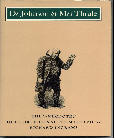|
HESTER LYNCH PIOZZI (MRS. THRALE) Mrs. Piozzi was born in Wales, very well educated and considered to be “half a prodigy”. As a young girl she had sat at Garrick’s knee and taught to recite passages from Paradise Lost by Quin, the actor. In 1763 she married Henry Thrale, a wealthy Southwark brewer. It was a marriage of convenience, Hester not having been alone with Henry Thrale for more than five minutes before the ceremony. They lived in amity for seventeen years, had twelve children, four surviving to adulthood. In 1764 a mutual friend, Arthur Murray, the playwright, brought Johnson to Streatham Park estate. This began a twenty-year intimacy. Johnson had his own rooms in the house and was treated as a permanent member of the family. He spent several days each week with them and accompanied them on trips to Wales and France. Many celebrities visited Streatham to meet Dr. Johnson and enjoy the Thrale’s prodigious hospitality. Included among the recurring guests were Joshua Reynolds, Edmund Burke, David Garrick, Oliver Goldsmith, Sir Robert Chambers, Charles and Fanny Burney, James Boswell, etc.
Thrale became a Member of Parliament representing his borough. He made poor business decisions resulting in his brewery being put into potential bankruptcy. Mrs. Thrale and Dr. Johnson became very involved in obtaining financial assistance and keeping the creditors at bay, ultimately saving the business. Thrale never recovered from this experience and finally killed himself with his uncontrollable eating behavior. Upon his death in 1781 the brewery was sold (it is now part of Barclay’s). Mrs. Thrale stated, “Johnson never left him, for while his health remained he still hoped.” According to Johnson, “I felt almost the flutter of his pulse, and looked for the last time upon a face that for fifteen years had never been turned upon me but with respect and benignity.” Mrs. Thrale fell in love (for the first and last time) with Gabriel Piozzi, an Italian music master who had been employed by Henry Thrale to give lessons to their eldest daughter who had been nick-named Queeney by Dr. Johnson. Friends and family strongly disapproved. Newspapers and gossip mongers castigated her. Peter Pindar wrote eclogues about her. Boswell wrote a most derogatory poem. Johnson was bitterly opposed to the anticipated wedding resulting in a complete and permanent break between them. It was felt by mutual friends that Mrs. Thrale should have been willing to continue to care for Johnson who was now an old and ailing man. Marriage to a Catholic foreigner was considered beneath her. Her family finally relented when she became deathly ill and physicians feared for her life because of the constant vehement opposition. The relationship between mother and daughters never became closer than required by the rules of civility. In 1784 Mrs. Thrale became Mrs. Piozzi. The marriage was a very happy one, “he being as much of an Englishman as a foreigner could expect to be”. After Piozzi’s death in 1809, she returned to Bath, where having been once again accepted by much of society was described by Fanny Burney as “a very pretty woman still; she is extremely lively and chatty; has no supercilious or pedantic airs, and is really gay and agreeable”. She died at age 80 and was buried next to her second husband. Today she is mostly remembered for her small books, “Anecdotes of the Late Samuel Johnson, LL.D., During the Last Twenty Years of His Life” and “Letters To and From the Late Samuel Johnson, LL.D., to Which Are Added Some Poems Never Before Printed”. These are considered to be second only to Boswell’s Life of Johnson in providing an accurate portrait of the great moralist. Her diaries first published in 1942 under the title “Thraliana” give a fine insight into life as it was during the last part of the eighteenth century. Her letters have just been published in a six-volume edition. |
||
|
James Boswell | Hester Lynch Piozzi | Samuel Johnson | Miscellany |
 An
imaginary dialogue based
An
imaginary dialogue based The
bon mots, infamous views and gossip of Samuel Johnson as recorded by
Mrs. Thrale. Edited to commemorate the 200th anniversary of his death.
The
bon mots, infamous views and gossip of Samuel Johnson as recorded by
Mrs. Thrale. Edited to commemorate the 200th anniversary of his death.
